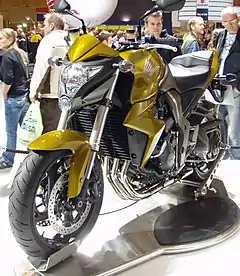Honda CB1000R
The Honda CB1000R is a CB series 1,000 cc (61 cu in) four-cylinder standard or naked motorcycle made by Honda from 2008 to 2016, and resumed from 2018.[2]
 2008 Honda CB1000R | |
| Manufacturer | Honda |
|---|---|
| Production |
|
| Predecessor | Honda CB900F |
| Class | |
| Engine | 998 cc (60.9 cu in) liquid-cooled 4-stroke 16-valve DOHC inline-four |
| Bore / stroke | 75 mm × 56.5 mm (2.95 in × 2.22 in) |
| Compression ratio |
|
| Power |
|
| Torque |
|
| Transmission | 6-speed constant mesh, chain |
| Frame type |
|
| Suspension |
|
| Brakes | Front: 2 × 310 mm (12 in) disc, radial 4-piston calipers Rear: 256 mm (10.1 in) disc |
| Tires |
|
| Rake, trail |
|
| Wheelbase |
|
| Dimensions | L:
W:
H: 1,095 mm (43.1 in) |
| Seat height |
|
| Fuel consumption |
|
It was unveiled at EICMA November 2007 as a replacement for the CB900F Hornet, the US-market's 919.[3]
The CB1000R's styling cues are borrowed from the 2007 CB600F Hornet. The engine is a detuned version of the 2007 CBR1000RR engine, and produces about 81.61 kW (109.44 hp) at the rear wheel.[1] The front suspension uses a 43 mm (1.7 in) inverted HMAS cartridge-type telescopic fork with stepless preload with compression/rebound adjustments and 110 mm (4.3 in) travel. The rear is a monoshock with gas-charged HMAS damper with 10-step preload and stepless rebound damping adjustment and 130 mm (5.0 in) axle travel.
In November 2017, Honda unveiled the new iteration of the CB1000R, along with the CB125R and CB300R.[4][5][6][7] The bike uses a new styling direction dubbed as Neo Sports Café. This design language has been applied before to the CB150R ExMotion and then applied to the CB650R, the successor of the CB650F.
References
- "Performance Index Winter '12/'13 Edition" (PDF). Motorcycle Consumer News. Bowtie Magazines. January 2013. Archived from the original (PDF) on 2016-12-29. Retrieved 2016-09-12.
- "2008 Honda CB1000R". Honda UK. Retrieved 2007-12-01.
- Edge, Dirck (2007-11-06). "Honda Rocks Milan With New CB1000R". Motorcycle Daily. Archived from the original on 2007-11-08. Retrieved 2007-12-01.
- https://www.motorcycle.com/manufacturer/honda/first-look-2018-honda-cb1000r.html
- https://ultimatemotorcycling.com/2017/11/06/2018-honda-cb1000r-first-look-fast-facts-sport-motorcycle/
- https://indianautosblog.com/2017/11/2018-honda-cb1000r-neo-sports-cafe-revealed-289664
- https://www.motoroids.com/news/2018-honda-cb1000r-unveiled-at-2017-eicma-motor-show-details-features-tech-specs-and-image-gallery/
| Wikimedia Commons has media related to Honda CB1000R. |